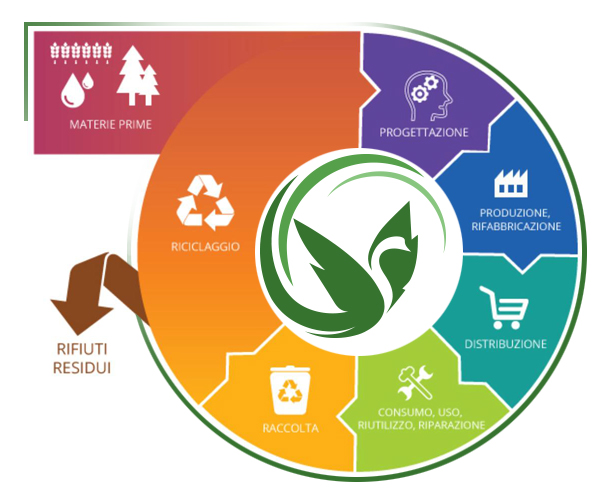CIRCULAR ECONOMY
“The snake that cannot change its skin is doomed to die. Even the minds that are prevented from changing their opinions, cease to be minds.” Friedrich Nietzsche
What is circular economy?
We refer here to the definitions and official documents of the European institutions.
The circular economy is a model of production and consumption that involves sharing, lending, reusing, repairing, reconditioning and recycling of existing materials and products for as long as possible. This extends the life cycle of products, helping to minimise waste. Once the product has completed its function, the materials of which it is made from are in fact reintroduced into the economic cycle wherever possible. In this way they can be continuously reused within the production cycle, generating additional value.
The principles of circular economy contrast with the traditional linear economic model, based instead on the typical “extract, produce, use and throw away” scheme. The traditional economic model depends on the availability of large quantities of easily available and cheap materials and energy.
The European Parliament also demands that measures be taken against planned product obsolescence, which is a strategy inherent in the linear economic model.

Why is the transition to a circular economy necessary?
We are facing an increase in demand for raw materials and at the same time a scarcity of resources: many of the raw materials and resources essential to the economy are limited, but the world population continues to grow and consequently the demand for these finite resources also increases.
This need for raw materials creates a dependency on other countries: some EU Member States are dependent on other countries for their supply.
We must not forget the impact on the climate: the processes of extraction and use of raw materials have a great impact on the environment and increase energy consumption and carbon dioxide (CO2) emissions. A more rational use of raw materials can help to reduce CO2 emissions.
What are the benefits?
Through measures such as waste prevention, eco-design and re-use of materials, European companies would achieve net savings of €600 billion or 8% of annual turnover, while reducing total annual greenhouse gas emissions by 2-4%.
The transition to a more circular economy can bring many benefits, including:
- Reduction of pressure on the environment
- More security about the availability of raw materials
- Increased competitiveness
- Impetus for innovation and economic growth
- Increased employment – it is estimated that there will be 580,000 new jobs in the EU thanks to the circular economy
With the circular economy, consumers will also have more durable and innovative products that save money and improve their quality of life. For example, reconditioning light commercial vehicles instead of recycling them could lead to material savings of €6.4 billion per year (around 15% of material costs) and €140 million in energy costs, reducing greenhouse gas emissions by 6.3 million tonnes.
The new business models of the circular economy
Circular business models are the key to making companies and non-profit organizations (charities) the protagonists of a sustainable future. We offer four best-known circular business models:
- Product as a service: Through the product as a service model, customers use the products through a lease or payment agreement compared to the traditional buy-to-own approach. This model is interesting for companies that have high operating costs and the ability to manage the maintenance of that service and recover residual value at the end of its life.
- Life-extension: The product life extension model helps companies extend the life cycle of their products by mainly improving product quality. By extending the product life cycle as long as possible, companies can keep materials out of landfills and discover new sources of income.
- Upcycling: The resource recovery business model takes advantage of technological innovations and capabilities to recover material losses, reworking them to maximize economic value.
- Shared Platform: The sharing platform model focuses on sharing products and resources with a low ownership or usage rate. Companies that leverage this model can maximize the use of the products they sell, improve productivity and value creation.
- Circular supplies: The business model of circular supplies is particularly relevant for companies dealing with scarce goods, where scarce resources are replaced by fully renewable, recyclable or biodegradable resource inputs.
Per saperne di più sull’economia circolare
- http://www3.weforum.org/docs/WEF_ENV_TowardsCircularEconomy_Report_2014.pdf
- https://www.europarl.europa.eu/thinktank/infographics/circulareconomy/public/index.html
- https://www.ellenmacarthurfoundation.org/assets/downloads/publications/Achieving-Growth-Within-20-01-17.pdf

